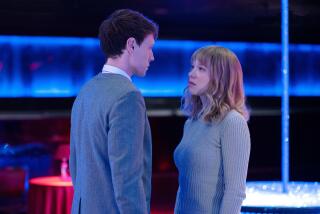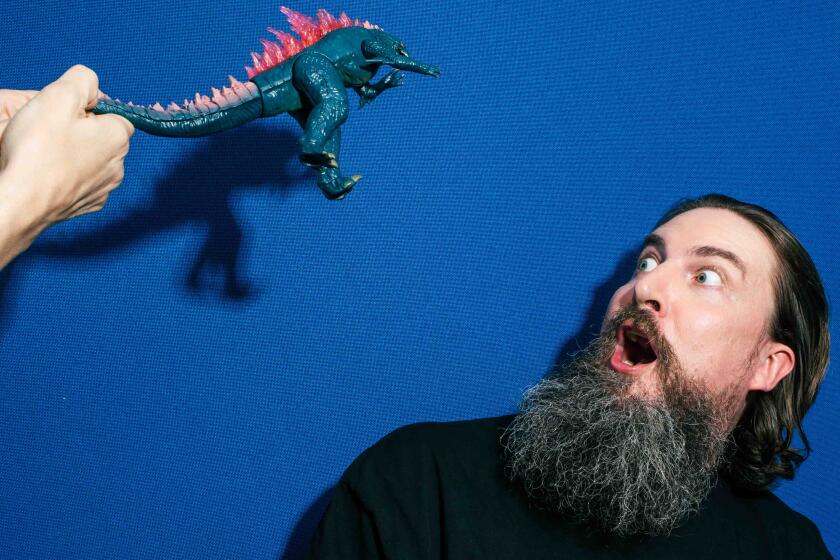‘Little Robot’ comic exclusive shows why it’s hard to be the only working robot in the junkyard
Ben Hatke’s “Little Robot” follows the friendship that develops between a lost robot and a young girl who is handy with tools.
An unnamed girl discovers the robot while exploring the woods near a junkyard, and after activating him, spends her days showing him around her world. Of course, like most friendships, their relationship is not without its misunderstandings. And unlike most friendships, they have to fight off a giant robot sent to retrieve the little bot.
Cute robots are great, but even more great is that this story — about an intersentient relationship — stars a shy, smart, young girl of color.
The all-ages graphic novel from First Second hits shelves Sept. 1, but Hero Complex readers are getting an exclusive preview of the book in the gallery below. In it, we get a glimpse of how even robots who don’t speak words can say mean things when they’re sad.
Author and illustrator Hatke is best known for his “Zita the Spacegirl” graphic novel series, about a girl who finds herself an intergalactic hero after she takes to space to rescue her best friend who was abducted by an alien doomsday cult. He also is known for the children’s book “Julia’s House for Lost Creatures.”
Hero Complex caught up with Hatke over email to discuss “Little Robot,” the little girl and his inspired song selection.
“Little Robot” originated in a series of comic strips that you created, but what was it about the character that kept bringing you back?
The robot is such a fragile little personality! The other thing is that visually, when I was making the “Little Robot” strips, it was a fun challenge to see how much emotion I could pull from a very simply designed character.
There have been a number of TV shows and films this year that involved robots or artificial intelligence in one way or another. What do you think it is about robots that fascinates people?
There’s so much you can do with the idea of a mechanical, created being. From Pinocchio to Data, it’s a thing that never gets old. Robots hold up a little mirror and let us look at ourselves.
Do you have a favorite movie or series that involves robots?
I’ve been wanting to re-watch both “Short Circuit” and “Wall-E.” There seem to be a lot of sleek Apple-looking robots these days, but I have a real personal preference for clunky old bots with rougher edges that look like they were banged together with spare parts.
So much of “Little Robot’s” story is conveyed by sounds and a scene’s visual elements more than actual spoken words. Did you feel restricted at all with a narrative that didn’t really rely on any dialogue to carry it forward, or was it sort of freeing in a way?
It was definitely not a restriction. If anything it was an opportunity to push forward with my idea that in comics (and probably most other visual storytelling) it’s best to let the visual element do most of the heavy-lifting.
The little girl in the story doesn’t have a name. What made you decide to keep her nameless? Did you ever give her a name that just didn’t get included in the story?
Yeah, she has a name in my mind, but I don’t want to say it because I like her to remain just that: unnamed. It fits the story, and I hope it makes it easier for readers to identify or put themselves into her place.
While Little Robot brings out the little girl from her shell a little as she shows him the world and they grow closer, she definitely remains a shy, introverted girl who just happens to be really skilled at tinkering with things throughout the story. What made you decide to focus on such a quiet protagonist? What parts of her did you connect with as you brought her to life? Are you at all handy at tinkering with machines?
Ha! Well, part of the answer, to be honest, is that I just wanted to make sure I created a character that was different both visually and temperamentally from both Zita and Julia (from my other books).
I ended up drawing this girl over and over in my notebooks until, gradually, both her design and her personality took a definite shape. It felt like she was becoming who she was all along, and I just had to discover it. I really identify with some of the aspects of her personality.
I don’t do a lot of tinkering with machines, but my dad is definitely a maker and has passed that along to me. Growing up, he was always building a catapult, or a potato cannon, or making a child-sized Victorian house (complete with turret!) out of scraps from someone’s torn-down garage. I’ve followed his example of making and inventing in my own small ways.
I have to ask. What inspired your decision to have Toto’s “Africa” be the song that plays in the book?
I don’t know! It just seems like what would be on an old cassette in the woods, right? I think at the time, one of our friends wanted to do a lip-sync contest, and I briefly thought of doing that song.
Twitter: @tracycbrown
More to Read
The biggest entertainment stories
Get our big stories about Hollywood, film, television, music, arts, culture and more right in your inbox as soon as they publish.
You may occasionally receive promotional content from the Los Angeles Times.







